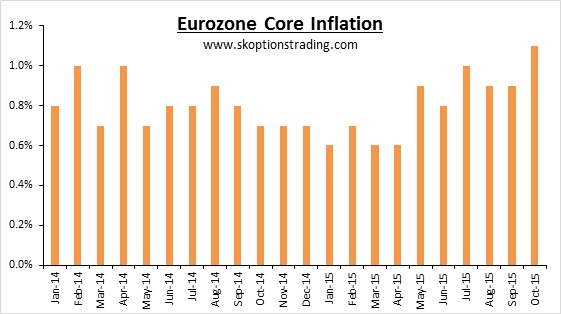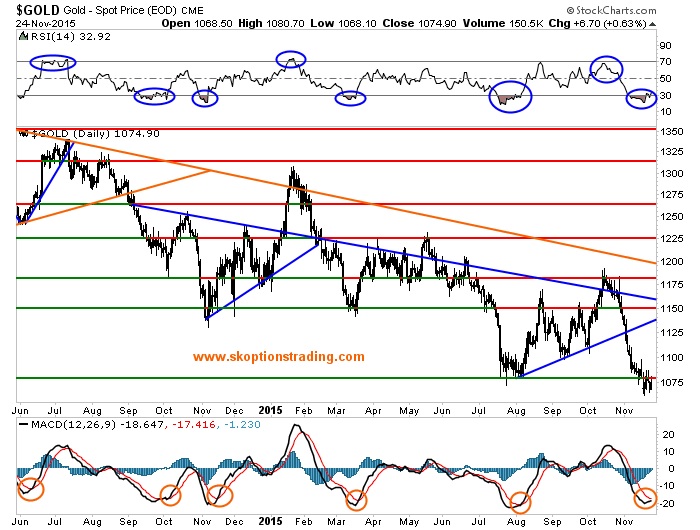The threat of deflation in the Eurozone is an issue that continues to plague the ECB. The current easing measures have failed to drive inflation above 0.3%, which is far short of the 2% inflation target that the ECB is mandated to reach. This has led ECB President Mario Draghi to begin the discussion of further QE to stimulate prices in the region. Just last week Draghi commented that:
“We consider the APP [asset-purchase programme] to be a powerful and flexible instrument, as it can be adjusted in terms of size, composition or duration to achieve a more expansionary policy stance… We will do what we must to raise inflation as quickly as possible. That is what our price stability mandate requires of us.”
Dovish remarks such as these signal the markets that more QE is coming from the ECB. Following the GFC, massive quantitative easing from the Fed drove gold prices to new all-time highs, yet similar sized programs, including those of the ECB, have failed to fuel a bull market in gold. Here we will discuss why an increase in the ECB’s easing measures now will not just fail to be bullish for the metal, but will in fact be likely to drive gold prices lower.
The Currency Argument
New QE from the ECB will see the euro weaken relative to the USD. The chart below clearly shows that since the ECB first began discussion of new easing measures in mid-2014, the euro has fallen significantly. We believe that this decline is likely to continue as we approach the launch of fresh easing from the ECB.

In the US, the Fed is moving ever closer to the beginning of a new tightening cycle. Increasingly hawkish statements from the Fed and speculation that the first hike will come this December have led to the USD reaching 10-year highs. This strength has also been a product of the monetary policy of other central banks moving in the opposite direction. Case in point, the ECB introducing more quantitative easing.
Now consider the effect of a stronger US dollar on gold. Historically as the US dollar has rallied gold has fallen in US dollar terms, and vice versa. Therefore, if the US dollar strengthens then one would expect gold to decline. Given that the US dollar and Euro often have an inverse relationship, it is clear that if the Euro weakens, then gold could follow suit. Accordingly, we reach the conclusion that from a currency standpoint alone, gold will fall if the ECB increases their monetary easing programs.
Why ECB QE Will Not Be Bullish For Gold
Many gold bulls in 2014 called that the introduction of new QE would re-ignite the bull market and drive the yellow metal to new all-time highs. The reasoning was simple, QE from the Fed had fueled the gold bull market for years, so why should QE from the ECB be any different?
The answer to this is simple, ECB QE has had a different effect on gold, because it is a different type of program. The measures used by the Fed during QE1 and QE2 were broad-based programs. Their goal was to stimulate the economy by keeping interest rates low. To do this the Fed targeted buying long-term Treasuries to push the price of that debt higher and the yields lower.
However, this has not been the goal of the ECB. Long term interest rates are already at all-time lows, so instead the ECB’s QE programs target Asset Backed Securities (ABS) to incentivize bank lending. An ABS is a financial security backed by a loan, lease or receivables against assets other than real estate and mortgage-backed securities. This means that the ECB’s QE program was similar in nature to QE3 from the Fed, which targeted Mortgage Backed Securities (MBS).

Given that the ECB is already using targeted QE and that targeted QE has been successfully used in the US, it’s logical that the ECB will again use targeted QE. This means that they will not use the broad based measures similar to QE1 and QE2 that drove gold higher. Therefore we do not expect that new easing from the ECB will drive gold higher.
ECB QE Will Be Directly Bearish
Targeted programs will be used when the ECB increases their easing measures. We have established that these will not have a bullish effect on gold as they differ subtly but significantly from the easing programs that fuelled the gold bull market. However, we are yet to cover why new measures in Europe will drive gold lower, rather than simply not push the metal higher.
In the US, QE3 was successfully used to stimulate growth and improve the health of the employment sector. While the employment sector has not recovered to full strength, shown by a lack of significant wage inflation, jobs growth has been considerable. Therefore, although employment has not reached its full potential, QE3 has resulted in an economy that is ready for higher rates and tighter monetary policy. This means that targeted measures can be effectively used to improve long term economic health.
If this conclusion extends beyond the US, which we and most economists agree it does, then targeted QE can be used to increase inflationary pressures in Europe and avoid the threat of deflation. From this we can see that if the ECB’s new QE programs are successful, then over the long term inflation and economic health in the Eurozone will rise.
This means that further measures are unlikely to be necessary, and that in fact over the longer term monetary policy will begin to tighten, which will be highly bearish for gold. This view will likely be priced in to markets as the ECB’s QE is shown to succeed, which means that gold is likely to be sold off as the new measures take effect.
As the economic health of the Eurozone increases, we are also likely to see gold sold off as a safe haven asset. Improvements in the economy generally lead to investors becoming less risk averse, as the probability of a significant downturn is decreased. This means the "risky" assets, such as stocks, become more favourable than safe haven assets, such as gold. Therefore gold is likely to be sold as the economy improves simply because it is a safe haven asset.
Accordingly, we believe that fresh QE from the ECB will be directly bearish for gold, rather than just non-bullish.
What If the New Measures Don’t Work?
The argument can be made that the current measures from the ECB have failed, as these now need to be increased to combat the still weak inflation outlook, and that because they have failed all future programs will also fail. We believe that this argument is flawed for a two key reasons.
Firstly, the view that just because the most recently announced easing programs from the ECB have been unsuccessful, all future attempts will also be futile is naive. In the US, QE3 was the third round of easing from the Fed under the quantitative easing banner, and even QE3 was initially considered unsuccessful. After being announced in September 2012 the Fed increased QE3 at their December meeting that year. This shows that the initial program may not achieve all of the desired targets, but can still be successful when increased or adjusted.

Secondly, although the inflation situation in Europe is poor, it has not severely weakened. In fact, core inflation has improved in the region with a print of 1.1% in October. While this appears soft on the surface, it is worth noting that in the US core inflation is only 1.9% and the Fed is approaching a rate hike. This means that although the current ECB measures are not enough, they are on the right track. Therefore it is likely that an increase in ECB QE would be effective in the same way that the increase in QE3 was.
When we consider the effect on gold prices, the key factor is the markets perception of the programs. It matters little whether one personally believes that the current measures have worked, as the markets hold the view that they will work over the long term. This means that the long term effect of gold being lower due to higher interest rates will likely be priced in while the programs are in place. This is true regardless of whether they are effective at that time, as markets believe that the ECB’s action will eventually drive growth in the region, which will necessitate higher rates.
How to Trade Gold from Here
We hold the view that more QE from the ECB will be bearish for gold prices. Additionally, we believe that the Fed will hike this December and that this action will drive gold lower. Together these actions are likely to drive the US dollar higher and gold consequently lower. Therefore, we clearly believe the right trade is to be short gold. But when is now the right time to open new shorts?
Gold has fallen around $100 since mid-October when the Fed signaled that they would hike in December if data remained steady. This selloff has led to the yellow metal becoming oversold, as shown by the RSI, which is currently at 32.92. The MACD is also poised for a sub-zero bullish crossover. These crosses have often signaled a rise in bullish momentum and at least a small rally higher. Therefore gold has the technical potential to move higher from here.

The $1080 level is likely to impede this, but gold has failed to break significantly beneath that level. This indicates that the resistance is yet to be fully broken, and therefore is unlikely to fully stop a rally higher if gold breaks to the upside.
Although we hold the view that the fundamentals are highly bearish for gold, we admit that the current technicals show that the metal has the potential to move higher in the near term. Therefore we would not look to add new gold shorts at this stage. Whilst we are maintaining a core short, we intend to wait until gold approaches resistance at $1150 before adding new short trades. This would ensure that these positions are opened at optimal levels to take advantage of the bearish effects of new ECB QE.
Disclaimer: SK Options Trading makes no guarantee or warranty on the accuracy or completeness of the data provided. Nothing contained herein is intended or shall be deemed to be investment advice, implied or otherwise. This letter represents our views and replicates trades that we are making but nothing more than that. Always consult your registered advisor to assist you with your investments. We accept no liability for any loss arising from the use of the data contained on this letter. Options contain a high level of risk that may result in the loss of part or all invested capital and therefore are suitable for experienced and professional investors and traders only. One should be familiar with the risks involved in options trading and we recommend consulting a financial adviser and/or viewing the SEC Options page if you feel you do not understand the risks involved in options.
